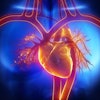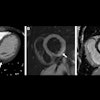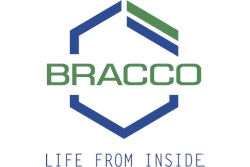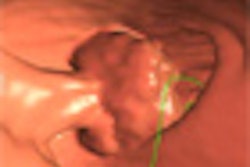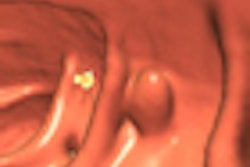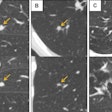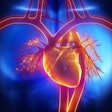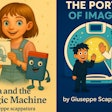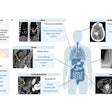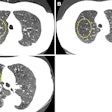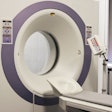Good bowel preparation and distention are the two most important steps toward a highly effective virtual colonoscopy exam, according to University of Wisconsin VC providers Dr. Perry Pickhardt and Dr. Louis Hinshaw.
The two gastrointestinal radiologists from the university's department of radiology outlined their methods at the Society of Gastrointestinal Radiologists (SGR) Abdominal Radiology Course in Carlsbad, CA, last month. They offered a shared presentation about what they've learned from thousands of procedures for getting optimum results with virtual colonoscopy (also known as CT colonography or CTC), as well as lessons that have developed into common practice at their hospital.
In a nutshell: Prep is everything.
"How do we improve sensitivity without making the test too burdensome?" said Hinshaw. "We looked through the data and tried to figure out why the tests got better, and we found some very specific things we've incorporated into our practices over time."
Along with a proven cocktail of agents to tag stool and fluids, and flush patients' colons, achieving adequate colonic distention is critical, according to Pickhardt.
"We've gotten comfortable calling things adequately distended," he said. "The goal is to optimally distend, not maximally distend. You just need good enough distention to see there's a polyp while you do your fly-through."
Not surprisingly, Pickhardt advocates mechanically inflating the colon with CO2 -- though he recalled how his U.S. Navy practice included patient participation.
"When I was in the Navy, we actually had patients self-administer [and] pump up their own colons," he said. "I think it's probably impossible to perforate yourself."
The regimen begins with doctors' orders for a clear liquid diet and no red liquid. Patients take two bisacodyl 5-mg laxative tablets and a glass of clear liquid. Between 2:00 p.m. and 6:00 p.m., the patient drinks one bottle of magnesium citrate and 4 to 6 cups of clear liquid. Three hours later, the patient drinks 250 mL of liquid barium sulfate, a second bottle of magnesium citrate, and 4 to 6 cups of clear liquid. Between 7:00 p.m. and 11:00 p.m., the patient consumes a bottle of diatrizoate iodinated oral contrast solution that can be mixed with clear liquid.
"There's a reason for everything we do," Hinshaw said. "Good bowel prep is one of the biggest things we learned about and changed our approach as we learned."
For example, the Wisconsin radiologists no longer include the stool softener Docusate with the patient's prep. "We started seeing our patients coming in with a fine layer of barium and stool over the cecum, primarily," he said. The problem disappeared when the Docusate was eliminated, he said.
Hinshaw participated in a study led by his University of Wisconsin colleague Dr. David Kim in 2007 that found that for cleansing the colon, a single dose of sodium phosphate works as well as a double dose, lightening the patient's intake of fluids. But since then he's found that magnesium citrate leads to better fluid attenuation at CT than sodium phosphate.
"It can be pretty much a pain for the patient. The more we can minimize the bowel prep, the better," Hinshaw said. "With current techniques, you really need to optimize bowel prep for best results."
Pickhardt said there are some tricks to using an automated CO2 insufflator (ProtoCO2l, Bracco Diagnostics) -- but they're well worth learning for patient comfort, increased safety, and good images. Inasmuch as carbon dioxide is rapidly absorbed in the colon, the insufflator stays on for the duration of the procedure and scans are done once the pressure reaches equilibrium between 20 and 29 mmHg.
"Automated CO2 delivery provides for safe, user-friendly, and patient-friendly distention," Pickhardt said.
One thing Pickhardt likes about the automated insufflator are the two safety switches: an electronic cutoff when the pressure reaches 50 mmHg and a mechanical release at 75 mmHg.
"The techs love this," he said. "The patient gets back to normal and feels comfortable as soon as you turn this off."
In nearly 22,000 exams, they've seen one perforation -- probably from pre-existing damage, he said. But he warned that it's important to beware of colonic inguinal herniation.
Pickhardt's team has also seen pneumatosis, or gas cysts on the bowel wall, in 0.1% of patients who had received CO2. The patients were asymptomatic and didn't need supportive or therapeutic measures, Pickhardt said, and the condition went away within minutes, but it was worrisome the first few times.
Other important tips included taking the image when the patient has inhaled and then exhaled a deep breath, that carbon dioxide has to be infusing when the images are acquired, and that it's important to ramp up the pressure in the colon slowly. Too fast is "where the discomfort is," he said.
Approximately 10% of patients get a decubitus scan series. "The decubitus view is usually the best,'' Pickhardt said.
The scout view provides an indication of overall distention, but it can look better than the image and vice versa, he said. For cases with focal collapse of a colonic segment on both supine and prone views, perform a third series with the decubitus position, he advised.
In the end, good images come down to good prep, they emphasized. Hinshaw said that he's been called into the gastrointestinal suite for help with imaging, and the first thing he asks is how the bowel prep went.
"If it was horrible, I prefer [that the patient] come back another time," Pickhardt said. "This is really common-sense stuff. It doesn't matter how good your machine is or how good your fly-throughs are if you haven't got a good prep."


